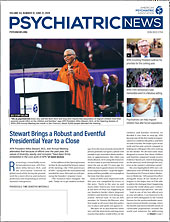A middle-aged woman with posttraumatic stress disorder as well as a history of depressive and borderline personality traits walks into her psychiatrist’s office and requests electroconvulsive therapy (ECT). She was recently discharged from the hospital following a suicide attempt, and so far has failed to respond to both medication and transcranial magnetic stimulation. What should the psychiatrist do?
This scenario and many others were discussed as part of an interactive session that explored the many factors psychiatrists must weigh when considering ECT for a patient. The scenarios covered decisions related to how to select patients most likely to benefit from the procedure, informed consent, anesthesiology considerations, electrode placement, and whether to taper/discontinue medications.
Of these topics, the session moderators Keith Rasmussen, M.D., Simon Kung, M.D., and Teresa Rummans, M.D.—all psychiatry faculty at the Mayo Clinic—agreed that patient selection is the hardest part of the process. They highlighted four diagnoses for which ECT is widely recommended: catatonia, delirious mania, an acute schizophrenia exacerbation, and psychotic depression. Beyond that, the broad range of depressive criteria and the interaction of depression with other illnesses pose many challenges when assessing a patient.
While an ECT algorithm might suggest the patient described above would benefit from ECT, a closer look at the patient’s symptoms might suggest otherwise.
“Over the years, this lore has been passed down that ECT helps prevent suicide,” Rasmussen said. “But not all suicidality is created equal.” Many patients who may initially appear to have major depressive disorder might have adjustment disorder with depressed features or borderline personality disorder, for which ECT may not work.
ECT should also be given with caution if patients actively lobby for this procedure. As was pointed out, the woman in the case study noted above requested ECT prior to any discussion with the psychiatrist. “Patients who request this therapy often have strong expectations for how it will work,” Rasmussen said, which could be troublesome if the therapy fails to meet their expectations. Also, some eager patients may have a somatization syndrome and just want to be treated for the sake of treatment, he said.
Once a patient receives a recommendation for ECT, there are additional factors that a treatment team must consider. For instance, session attendees debated whether ECT electrodes should be placed on one side (unilateral) or both sides (bilateral) of the head. Rasmussen noted that extensive research to date shows that unilateral and bilateral electrode placements are equally effective at alleviating depressive symptoms, though bilateral placement is far more popular among psychiatrists despite the slightly higher risk of memory loss.
Rasmussen, who acknowledged he is a strong believer in bilateral treatments, suggested that rating scale scores used in research studies do not capture all the nuances of depression recovery and that patients in research trials do not bear similarity to those seen in real-world clinics. “However, if a patient … expressed specific concerns about memory impairment, then I would go with the unilateral,” he said.
The question of sedatives was also discussed. A sizeable number of attendees preferred etomidate, since this agent has limited cardiovascular effects and no anticonvulsant properties; anticonvulsants can make it harder to elicit seizures. Other agents discussed included propofol, which has a short half-life, allowing for a more rapid patient recovery following ECT. The most critical issue is to maintain a good working relationship with the anesthesiologist and use his or her knowledge, “but psychiatrists have a right to express their opinion about the anesthetic,” Rasmussen said.
The session finished with a debate over the use of lithium during and after ECT treatment for patients already on lithium. Studies have suggested that lithium can increase risks of confusion and delirium in patients receiving ECT, though discontinuing lithium use by stable patients could increase the risk of mania during ECT. The room was evenly split between continue, discontinue, or continue at a reduced dose, which highlights how difficult a decision this can be.
Rasmussen said he believes that patients with bipolar disorder should be on some type of mood stabilizer during ECT and patients stabilized on lithium before ECT can remain on maintenance treatment. He noted that patients who are not in need of immediate ECT can be switched to another medication before starting ECT, but since many of the patients he treats with ECT are seriously ill or potentially suicidal, waiting is not an option. Another consideration is that several other mood stabilizers are anticonvulsants, and as noted above this property also complicates ECT procedures.
Studies show that once acute ECT sessions are completed, lithium augmented with an antidepressant can help prevent relapse in patients with unipolar depression. But there are few post-ECT data regarding lithium and bipolar depression, so for patients with bipolar depression who were taking another mood stabilizer while undergoing ECT, there is no compelling evidence to switch them to another mood stabilizer, said Rasmussen. ■

